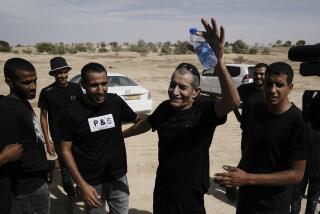New Route Across Israel Links Major Palestinian Areas
- Share via
EREZ CROSSING, Gaza Strip — Israel opened a safe-passage corridor Monday that links the Palestinian-controlled Gaza Strip and West Bank, allowing hundreds of Palestinians for the first time to traverse the Jewish state in search of a taste of freedom, a long-unseen relative or a job.
Most of the early travelers along the 34-mile route were young men armed with new permits and delighted to abandon the Gaza Strip.
“I never even dreamed of this,” said Sami abu Shaar, a skinny 22-year-old sewing factory worker bound for Bethlehem. Like many of the travelers, Abu Shaar was making his first foray outside the stifling borders of crowded Gaza, a desolate 140-square-mile patch of sand with nearly 1 million people and soaring unemployment.
“Gaza is too much like a prison,” Jihad Fahed Aff, a 28-year-old father of two, said before boarding a bus. “Everywhere is closed to us. I want to see Ramallah, Nablus, Janin. Now I will see my country.”
Israel and the Palestinians four years ago negotiated routes to improve freedom of movement between the two Palestinian enclaves. But the safe passage was never opened, in part because of Israeli fears that it would allow terrorists to infiltrate Israeli territory.
For average Palestinians, safe passage may be the single most significant step in the peace process because of its potential to improve their daily lives--especially in Gaza, hemmed in as it is by Egypt to the south, the Mediterranean to the west and Israel.
Only Palestinians with hard-to-get work permits have been able to enter Israel from the West Bank and Gaza, and they could not leave one Palestinian enclave and cross Israel to enter the other.
Israel controls access to both the West Bank and Gaza.
In another peace gesture Monday, Israel gave permission for an exiled hard-line Palestinian militant to enter Palestinian-ruled land. Nayef Hawatmeh, whom the Israelis hold responsible for a 1974 terrorist attack that killed 24 Israeli high school students, for many years opposed peace with Israel but has taken a more conciliatory stance recently and is making amends with Palestinian Authority President Yasser Arafat.
The safe-passage route is intended to accommodate 1,000 people a day, authorities said. The Palestinians who travel the route are still subject to Israeli security checks. Only Palestinians cleared by Israel are issued the magnetic identification cards they need to use the corridor. The cards are valid for one year.
Those considered a potential threat must travel in twice-weekly escorted buses.
Travelers’ luggage is X-rayed, their crossing of Israel is held to a strict timetable, and they may not stop along the way.
Nevertheless, Palestinian officials see the land link as another boost to their desire to establish an independent state within a year by uniting the enclaves and their people.
The mood was festive aboard the first bus to make the journey Monday morning. The young men aboard, with duffel bags and packed falafel lunches, sang Egyptian pop songs, clapped and celebrated. One passenger attempted to quiet them down periodically, begging for good behavior lest the Israelis be given a pretext to stop the bus and send it back home.
There was no Israeli escort for the bus.
The driver, a Palestinian, played the part of a tour bus chauffeur. Using a microphone, he announced the landmarks as they passed, including the ruins of an Arab village and the site of a legendary battle from the 1948 war that formed Israel. He gave the old pre-Israel Palestinian names for various villages.
Outside, the sparsely populated countryside rolled by: Cotton fields and lush orchards, a few housing developments under construction. American-style gasoline stations. An occasional Israeli army patrol.
Hatem abu Muhsin, 22, marveled at the huge eucalyptus trees he saw.
“If we had these trees in Gaza, we’d have chopped them down by now for firewood,” the third-year law student said quietly, his face glued to the window. “This is a beautiful country.”
As expected, the safe-passage route--which spans Israeli military checkpoints between Gaza’s Erez and the West Bank’s Tarqumiya--will at first be used primarily by those seeking to escape Gaza, where officials say 2,000 people have already applied for safe-passage permits.
By nightfall, 426 Palestinians in 11 taxis and eight buses had traveled from Gaza to the West Bank, and 17 had traveled in the opposite direction, Israeli army spokesman Shlomo Dror said.
Eventually, Palestinians will be allowed to drive private cars along the route too. Israelis will put a sticker on a car when it starts its journey and note the time. If it does not appear at the other end in a set amount of time, authorities will start searching for it.
Israeli officials concede that many of those traveling to the West Bank are in fact on a mission to enter Israel illegally because of the relative abundance of work there. Because of more lax checkpoints, it is easier to enter Israel from the West Bank than from Gaza, Dror said.
The safe-passage opening was met with nominal protests from Israeli right-wingers. A group of ultra-Orthodox yeshiva students waved banners at one point along the route, warning of “open passage for terrorists.”
“We want a safe passage if and when it is 100% safe and [poses] no danger for Israelis,” said demonstrator Haim Gross, 24. He said his brother Aharon was killed by terrorists in the West Bank city of Hebron in 1983.
The arrival of Gazans has triggered an altogether different form of anxiety among Palestinians in the relatively prosperous West Bank. Many West Bank residents are worried that they will be flooded by poorer, more desperate people from Gaza who will be willing to work for nothing.
For years, West Bankers have looked down their noses at their Gazan cousins, Palestinian political analyst Khalil Shikaki noted. Gazan society is much more strict and conservative. Young Gazan men, removed from those controls and on the loose in vibrant, relatively liberal cities such as Ramallah, with its dance clubs and night life, might run into trouble, he said.
“The feeling of West Bankers is the Gazans will now invade us and take away our work, not only in Israel but in the West Bank itself,” Shikaki said from his West Bank office in Nablus. “The Gazans think of themselves as being in a big jail, and now they’re free. Free to do what? That’s what the West Bankers are worried about.”
Unemployment in Gaza is sometimes twice that of the West Bank, according to official Palestinian statistics.
For workers like Abu Shaar, from the Gaza sewing factory, the choice is stark but obvious.
“If I find a job there, I will stay there,” he said on his way to the West Bank. “Most of the men here feel that way.”
Abu Shaar’s goal was to reach Bethlehem, a West Bank city 50 miles from his Gaza home.
“I’ve seen what Bethlehem looks like on TV,” he said. “There are a lot of buildings and a lot of construction. I expect it will be beautiful.”
His buddy, Bassem Hassanain, 31, had a different story. As a jewelry merchant, he has traveled from Gaza to 20 countries, always overland through Egypt.
“I can travel anywhere in the world, but until now I couldn’t travel to the West Bank,” he said.
Stuck in Gaza after a trip to visit his family, Hassan Ziayada, 38, was finally able to travel Monday to rejoin his wife in the West Bank. After two years of separation, huge phone bills and the possibility that the marriage would collapse, he could hardly wait to see her again and begin building a family.
“It is the end to my tragedy,” he said with a broad grin. “Thanks very much to safe passage.”
More to Read
Sign up for Essential California
The most important California stories and recommendations in your inbox every morning.
You may occasionally receive promotional content from the Los Angeles Times.











